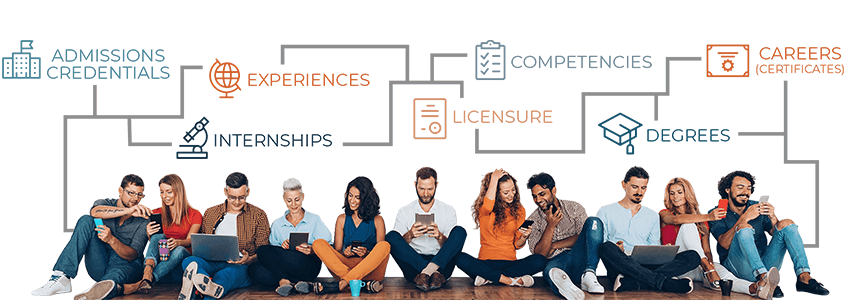
Schools and Employers Need to Work Closely Together to Ignite the Economy
The International Monetary Fund has predicted that the American economy is in the worst slump since the Great Depression. As we continue to navigate the impact of the Covid-19 pandemic and the effects on schools and businesses, every American sector and industry faces a new world. Because of this new reality, now more than ever, employers must closely align with colleges and other learning institutions to get “back in the black.”
The single, biggest struggle for companies, both large and small, is finding the right person with the right skills at the right time. Success requires alignment across the education-to-workforce continuum:
- Employers must understand the skills they need and develop a new view regarding recruiting talent.
- Learners must match their skills and attainment to roles and positions they are pursuing.
- Higher education institutions must strategize on how the lifelong support they can provide to learners.
Transparency is critical for hiring managers. Currently, learners, employers, and academia – all those using the education-to-workforce pipeline – struggle to both develop a lifelong learner’s skills and experience and match them to existing opportunities. The talent marketplace is hungry for a solution to address this issue. However, the solution must be flexible enough to both identify 1) when a learner’s skills do not match those employers are seeking and 2) how to close the gap. It should also provide a trusted, validated, and privacy-protected pipeline that enables employers to find talent based on skills and competency levels.
Moving to a skills-based economy demands that job and enrollment pipelines, as well as the paths to educational degrees, operate within the same ecosystem. This is where the Learning & Employment Record (LER) comes in.
A learning and employment record contains verifiable information about an individual’s achievements in education and/or training processes, whether in the classroom or workplace, that can be shared between learning institutions and employers.
To address this topic, the Clearinghouse has put into motion a learning and employment record pilot program. This program will focus on the cybersecurity industry with many trusted partners, including Western Governors University, Central New Mexico Community College, and IBM. This is part of the American Workforce Policy Advisory Board, which is being led by the U.S. Department of Commerce, IBM, Walmart, Salesforce, and Workday. This pilot aims to be a solution for the long-term education-to-workforce ecosystem.
For the Learning & Employment Record to work, four fundamental keys need to exist.
- Understandable and Consumable Content: Learning cannot be capture by just a traditional academic transcript anymore. Institutions, employers, policymakers, and others need to understand learning outcomes on a nationwide scale. Understanding the standards that are required by a Human Resource Management Information System (HRIS) to enable school-to-business, school-to-school, business-to-business, and business-to-school portability is essential. Part of this challenge is the need for open standards for data and skills taxonomies that allow HRISs to read, compare, and share the information contained inside a credential. This is essential for reliable, skills-based learning continuums to blossom and thrive.
- Reliable Data: Tomorrow’s learning transcript must capture learning as it’s happening, wherever it happens. It must also be portable to serve the learner’s purposes, not just that of the school. Trust and technology, like blockchain, are essential to ensuring the reliability of the data.
- Controllable Data: Both the issuer and the learner should be able to control the data, including modifying or resending documents and records. And the learner, who has a right to the artifact, must be able to share the record with anyone they choose and control how the data is used. This self-sovereignty that allows the learner to manage the utilization of the artifact is significant.
- Adoption at Scale: It is going to take time to adopt an LER process because adoption requires multiple technologies. Adoption will also depend on how education and workforce data come together within the context of a privacy framework.
Learning today is about verifiable knowledge, skills, and abilities and sharing that trusted data so that learners and employers can be empowered. To advance this overall effort, employers must demonstrate to schools and learners the skills and education needed. Amid the greatest education-workforce transition taking place in America, institutions and learners that look at their outcomes through these lenses are going to reap the greatest benefits.



